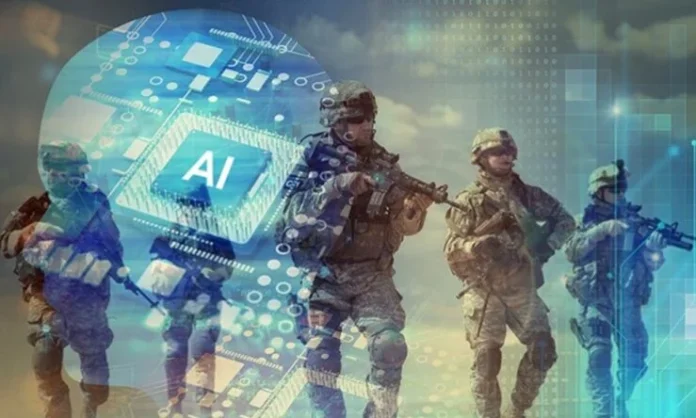The buzzword in the tech world these days is Chat GPT. Its enormous potential is forcing tech companies like Google, Microsoft and others to try to outdo each other in the race to integrate Chat GPT with their existing modules to make deliverables more efficient, more accurate and more time-saving, which in business terms implies a corresponding impact on cost.
While most of us are still toying with ChatGPT for mundane individualistic needs, others are already keen on using the artificial intelligence (AI) technology behind the chatbot for military use.
This goes without doubt that the advent of AI is rapidly changing the spectrum of warfighting. Recent drone engagements in Ukraine and improved surveillance and target acquisition capabilities using AI-supported hard and software are but just a glimpse of what is yet to come.
The fact that AI is a data cruncher and draws its strength from tracing a pattern from repetitive data inputs and thereafter offering a predictive output that is near factual, is no doubt a game changer in the realms of strategic decision-making. Apart from that, operations are always dynamic and may not follow a set pattern.
Generating Options
However, a machine interface with a huge bank of past data framework enables it to generate options that can be considered as more logical and actionable with the algorithm going beyond to even suggest the outcome given the parameters of combat application. Lancaster’s game theory can now be digitally played to arrive at a cognizable outcome.
In the realms of military operations, what is immensely gravitating is to access the adversary’s operational pattern in an all-arms environment, giving a more dynamic strategic picture for the higher directional framework.
At the operational and tactical level what goes in support of combat operations is factually repetitive in terms of combat fire support, ammunition management, logistic support, equipment maintenance, predictive causality handling capabilities, and training. In all these areas, AI has enormous potential and armies the world over have started welding AI technology into their calculus.
Results with Lightning Speed
While AI remained obscure in the cyber domain, the recent commercial release of Chat GPT has given a human-like interface to the use of AI that thrives on Internet-based data mining to arrive at results with lightning speed. Soon operations at the unit level will have access to Chat GPT-based information for local operations.
In so far as Airforce and Navy are concerned, the applications are enormous. In the ultimate analysis, ChatGPT mimics some aspects of human intelligence and transcends human abilities to process voluminous and diverse data to arrive at question-specific answers.
On the other hand, Lethal Autonomous Weapons Systems (LAWS) use AI to identify and kill human targets without human intervention. LAWS have colloquially been called “slaughterbots” or “killer robots”. Broadly, any competition for superior AI is sometimes framed as an “AI arms race”.

Latest Version
Thus, ChatGPT-4, the latest version released on 14 March 2023 by OpenAI with enhanced security features, is one of the most advanced multi-model AI tools that can generate creative as well as technical texts in real-time. In the current context, Chat GPT is designed to provide only nonmilitary operational solutions to queries. For example, on a query on ‘How to upgrade Indian Military Forces?’, the reply was generic:
“Upgrading the Indian military forces requires a comprehensive and systematic approach, involving various aspects of military strategy, planning, organization, training, and technology. Here are some steps that could be taken:
Increase the defence budget:
Technology acquisition and development:
Training and skill development:
Strengthening intelligence gathering capabilities:
Emphasizing joint operations:
Upgrading infrastructure:
Improving healthcare and welfare:
Overall, upgrading the Indian military forces requires a long-term commitment and a sustained effort across multiple fronts.”
Surprisingly, the answer, though generic, has indeed addressed key issues. How did OpenAI, the creator of ChatGPT, manage to identify and get the source data for arriving at the above suggestions is a big question?
Close to The Actuals
Therefore, If the response of ChatGPT is close to the actuals, can we exploit this tool for our military operations and tactics? On the contrary, when questions on military operations and tactics are posed, ChatGPT gives a reply to “maintain peace and restrain from war”. Therefore, ChatGPT is not designed to render military-specific solutions as of date.
Fundamentally, ChatGPT is an expert system tool with a language generation model including Natural Language Processing (NLP), text generation, and language translation. Being multi-model, it can process and integrate inputs in the form of text, images and sounds. Curation and refinement of suggestions rendered by ChatGPT have to be done to arrive at a near-perfect solution.
OpenAI, the creator of ChatGPT-4, does offer an API (Application Programming Interface) that allows developers to access and use ChatGPT’s capabilities for a fee. Additionally, OpenAI has released other AI-related tools and technologies as open-source software. In sum, the integration of Chat GPT in the present form requires solution-specific curation.
More importantly, there is also a need to customize the ChatGPT to suit military-specific requirements by providing authentic source data. Hence, as of now, ChatGPT can be exploited only as a fact finder. In addition, given the fact that military information is sensitive in nature, Chat GPT can at best be used for generic inputs based on open-source data. Thereafter a system-specific interface is required to arrive at effective military-specific requirements.
Conclusion
In conclusion, ChatGPT has the potential to greatly enhance and improve various military operations and capabilities. Its advanced language processing capabilities can be used to develop new techniques and algorithms for tasks such as automated target recognition, military robotics, material development systems testing, military medicine, battle space autonomy, intelligence analysis, record tracking, military logistics, information warfare, driverless vehicles, surveillance, lethal autonomous weapons systems, battlefield environmental support, virtual and augmented reality modelling and simulations, free air combat modelling, missile guidance, communications and network security, data fusion for situational awareness, swarm intelligence for swarm combat, autonomous flight control of UAVs, AI satellites and software-defined satellites, wearable systems for individual personnel, management of large amounts of military data, and counter-AI operations.
However, it is equally important to consider the ethical implications of using such advanced technology in military operations.
–The writer is a former GOC-Indian Army and presently a Strategic Consultant, Principal Advisor. Views expressed are personal and do not necessarily reflect the views of Raksha Anirveda
–The writer is a former GOC of the Indian Army and presently serves as a Strategic Consultant and Principal Advisor. The views expressed are of the writer and do not necessarily reflect the views of Raksha Anirveda







